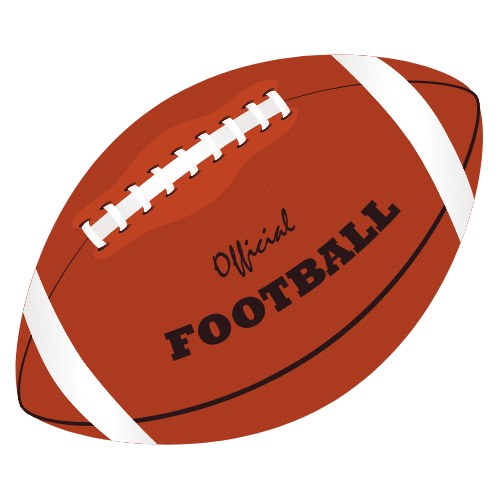Rule 2 - Definitions
SECTION 1. Approved Rulings and Official’s Signals
Article 1
a. An Approved Ruling (A.R.) is an official decision on a given statement of facts. It serves to illustrate the spirit and application of the rules.
b. An official’s signal [S] refers to the Official Football Signals 1 through 47.
SECTION 2. The Ball: Live, Dead, Loose, Ready For Play
Article 1 - Live Ball
A live ball is a ball in play. A pass, kick or fumble that has not yet touched the ground is a live ball in flight.
Article 2 - Dead Ball
A dead ball is a ball not in play.
Article 3 - Loose Ball
a. A loose ball is a live ball not in player possession during:
1. A running play.
2. A scrimmage or free kick before possession is gained or regained or the ball is dead by rule.
3. The interval after a legal forward pass is touched and before it becomes complete, incomplete or intercepted. This interval is during a forward pass play, and any player eligible to touch the ball may bat it in any direction.
b. All players are eligible to touch, catch or recover a fumble (Exceptions: Rules 7-2-2-a Exception 2 and 8-3-2-d-5) or a backward pass.
c. Eligibility to touch a kick is governed by kick rules (Rule 6).
d. Eligibility to touch a forward pass is governed by pass rules (Rule 7).
Article 4 - When Ball is Ready for Play
A dead ball is ready for play when:
a. With the 40-second play clock running, an official places the ball at a hash mark or between the inbounds marks and steps away to his position.
b. With the play clock set at 25 seconds, or at 40 seconds after an injury to or loss of helmet by a defensive team player, the referee sounds his whistle and either signals to start the game clock [S2] or signals that the ball is ready for play [S1]. (A.R.4-1-4:I and II)
SECTION 3. Blocking
Article 1 - Blocking
a. Blocking is obstructing an opponent by intentionally contacting the opponent with any part of the blocker’s body.
b. Pushing is blocking an opponent with open hands.
c. Continuous contact is a block where contact with an opponent is maintained for more than one second.
Article 2 - Below Waist
b. A blocker who makes contact above the waist and then slides below the waist has not blocked below the waist. If the blocker first contacts the opposing player’s hands at the waist or above, it is a legal ‘‘above the waist’’ block (Rule 9-1-6).
Article 3 - Chop Block
a. A block below the waist is a block in which the force of the initial contact is below the waist of an opponent who has one or both feet on the ground. When in question, the contact is below the waist (A.R. 9-1-10:I- IV).
b. A blocker who makes contact above the waist and then slides below the waist has not blocked below the waist. If the blocker first contacts the opposing player’s hands at the waist or above, it is a legal ‘‘above the waist’’ block (A.R. 9-1-10:V).
Article 4 - Block in the Back
a. A block in the back is contact against an opponent occurring when the force of the initial contact is from behind and above the waist. When in question, the contact is at or below the waist (see Clipping, Rule 2-5) (Rule 9-3-6). (A.R. 9-3-3:I-VII) (A.R. 10-2-2:XII).
b. The position of the blocker’s head or feet does not necessarily indicate the point of initial contact.
Article 5 - Frame (of the Body)
The frame of a player’s body is at the shoulders or below other than the back (Rule 9-3-3-a-1-b Exception).
Article 6 - Free-blocking zone
Article 7- Blind-side block
A blind-side block is an open field block against an opponent that is initiated from outside the opponent’s field of vision, or otherwise in such a manner that the opponent cannot reasonably defend himself against the block.
SECTION 4. Catch, Recovery, Possession
Article 1 - Possession
a. Player possession
The ball is in player possession when a player has the ball firmly in his grasp by holding or controlling it with hand(s) or arm(s) while contacting the ground inbounds.
b. Team possession
The ball is in team possession:
1. When one of its players has player possession, including when he is attempting a punt, drop kick or place kick; or
2. While a forward pass thrown by a player of that team is in flight; or
3. During a loose ball if a player of that team last had player possession; or
4. When the team is next to snap or free kick the ball.
c. A team is in legal possession if it has team possession when its players are eligible to catch or recover the ball.
Article 2 - Belongs To
Article 3 - Catch, Interception, Recovery
a. To catch a ball means that a player:
1. Secures firm control with the hand(s) or arm(s) of a live ball in flight before the ball touches the ground, and
2. Touches the ground in bounds with any part of his body, and then
3. Maintains control of the ball long enough to enable him to perform an act common to the game, i.e., long enough to pitch or hand the ball, advance it, avoid or ward off an opponent, etc., and
4. Satisfies paragraphs b, c and d below.
b. If a player goes to the ground in the act of catching a pass (with or without contact by an opponent), he must maintain complete and continuous control of the ball throughout the process of contacting the ground, whether in the field of play or in the end zone. This is also required for a player attempting to make a catch at the sideline and going to the ground out of bounds. If he loses control of the ball which then touches the ground before he regains control, it is not a catch. If he regains control inbounds prior to the ball touching the ground, it is a catch.
c. If the player loses control of the ball while simultaneously touching the ground with any part of his body, or if there is doubt that the acts were simultaneous, it is not a catch. If a player has control of the ball, a slight movement of the ball, even if it touches the ground, will not be considered loss of possession; he must lose control of the ball in order for there to be a loss of possession.
d. If the ball touches the ground after the player secures control and continues to maintain control, and the elements above are satisfied, it is a catch.
e. An interception is a catch of an opponent’s pass or fumble.
f. A catch by any kneeling or prone inbounds player is a completion or interception (Rules 7-3-6 and 7-3-7).
g. A player recovers a ball if he fulfils the criteria in paragraphs a, b, c, and d for catching a ball that is still alive after hitting the ground.
h. When in question, the catch, recovery or interception is not completed.
Article 4 - Simultaneous Catch or Recovery
SECTION 5. Clipping
a. Clipping is a block against an opponent in which the force of the initial contact is from behind and at or below the waist (Rule 9-1-5).
b. The position of the blocker’s head or feet does not necessarily indicate the point of initial contact.
SECTION 6. Deliberate Dead-Ball Advance
Deliberately advancing a dead ball is an attempt by a player to advance the ball after any part of their body, other than a hand or foot, has touched the ground or after the ball has been declared dead by rule (Exception: Rule 4-1-3-b Exception).
SECTION 7. Down, Between Downs and Loss of Down
Article 1 - Down
Article 2 - Between Downs
Article 3 - Loss of down
SECTION 8. Fair Catch
Article 1 - Fair Catch
a. A fair catch of a scrimmage kick is a catch beyond the neutral zone by a Team B player who has made a valid signal during a scrimmage kick that is untouched beyond the neutral zone.
b. A fair catch of a free kick is a catch by a Team B player who has made a valid signal during an untouched free kick.
c. A valid or invalid fair catch signal deprives the receiving team of the opportunity to advance the ball. The ball is declared dead at the spot of the catch or recovery. If the catch or recovery precedes the signal, the ball is dead when the signal is first given.
d. If the receiver shades his eyes from the sun without waving his hand(s), the ball is live and may be advanced.
Article 2 - Valid Signal
A valid signal is a signal given by a player of Team B who has obviously signalled his intention by extending one hand only clearly above his head and waving that hand from side to side of his body more than once.
Article 3 - Invalid Signal
An invalid signal is any waving signal by a player of Team B:
a. That does not meet the requirements of Rule 2-8-2 (above); or
b. That is given after a scrimmage kick is caught beyond the neutral zone, strikes the ground or touches another player beyond the neutral zone (A.R. 6-5-3:III-V); or
c. That is given after a free kick is caught, strikes the ground or touches another player (Exception: Rule 6-4-1-f).
SECTION 9. Forward, Beyond and Forward Progress
Article 1 - Forward, Beyond
Article 2 - Forward Progress
Forward progress is a term indicating the end of advancement by the ball carrier or airborne pass receiver of either team and applies to the position of the ball when it becomes dead by rule (Rules 4-1-3-a, 4-1-3-b and 4-1-3-p; Rules 4-2-1 and 4-2-4; and Rule 5-1-3-a Exception) (A.R. 5-1-3:I-VI) (A.R. 8-2-1:I-IX) (Exception: Rule 8-5-1-a, (A.R. 8-5-1:I)).



